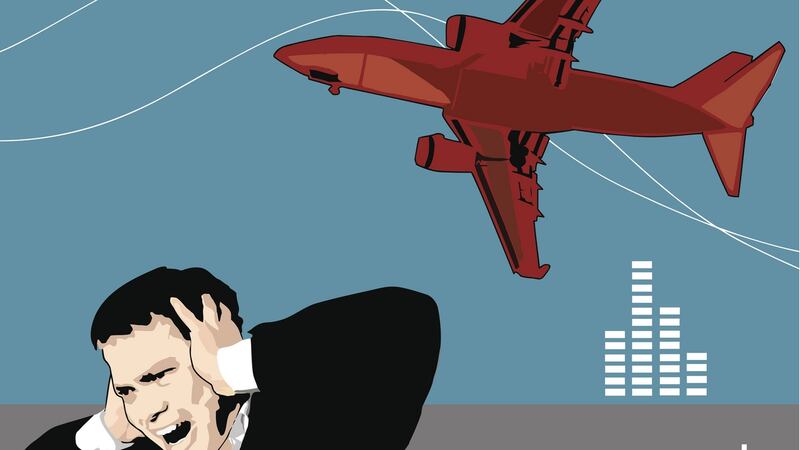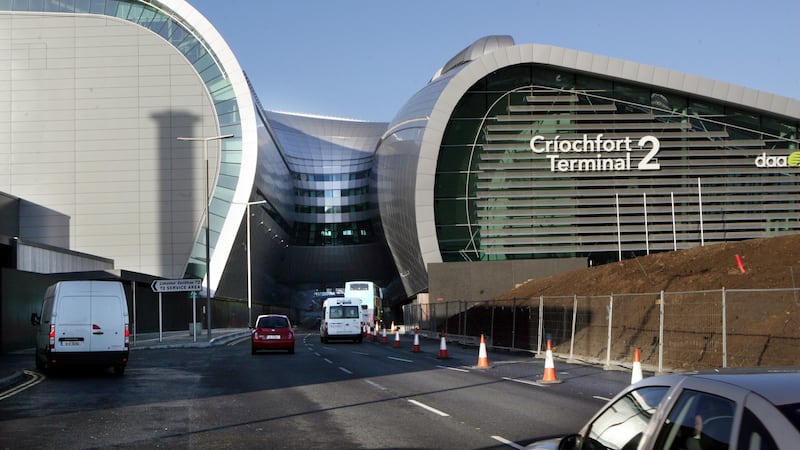Environmental noise has for a long time been referred to as the forgotten pollutant, probably because those of us living in urban areas grow accustomed to trying to ignore it. But because of the constant and rapid development of globalised economies and cities, the world is getting noisier. This means that nations are increasingly required to map noise in their urban environments.
Noise from sources such as roadways and airports is dangerous, and studies over recent years have demonstrated many associated negative health effects, including those related to long-term sleep disorders. In particular, various forms of stress are caused by excessive exposure to noise. This will be a concern for those affected by the planned new runway at Dublin Airport.
To assess noise levels and estimate the population who are exposed to urban noise, acoustic scientists and engineers generate sophisticated noise maps, which graphically represent urban areas based on how loud or quiet they are.


According to Dr Eoin King, an assistant professor at the University of Hartford in the US who trained at Trinity College Dublin, "noise mapping is the first step in the environmental noise management process".
By definition, noise is unwanted sound, which is loud, or unpleasant in other ways. It can be constant (think roads) or intermittent (think construction sites or motorbikes). Noise is particularly damaging near airports and around major roadways, meaning these infrastructures especially require noise mapping.
“The noise mapping process enables policymakers to determine the overall extent of noise pollution, so that appropriate decisions can be made,” says King.
Generating noise maps
Noise maps are almost entirely based on predictions, and their creation requires substantial data input.
For example, “If we know the quantity of vehicles on a road during a certain time period, along with other details such as the traffic composition and the speed vehicles are travelling at, we can calculate the ‘sound power’ of the road,” King says.
The creation of these noise maps, which aim to accurately represent noise levels across urban areas, is a complex process. One key problem with noise maps currently is that they are time-consuming to make, and also expensive.
But research published this year, led by Dr Enda Murphy, associate professor at University College Dublin, and King, has shown that noise maps can be created using simple smartphone apps. According to Murphy, who specialises in environmental noise assessment, smartphone apps are cheaper and easier, and in the near future will probably be just as effective as the older, more expensive methods for mapping environmental noise.
“We found that one iOS app – SLA Lite – consistently measured noise to within an average of one decibel of the true noise level,” he says.
The decibel, named after Alexander Graham Bell – the innovator credited with the invention of the telephone – is the unit used to quantify amplitude (related to how loud noise is). The app’s ability to measure noise levels to within a decibel is remarkable, especially given its low cost and ubiquitous nature, compared with traditional sound-level meters.
“This can open up the possibility of low-cost monitoring of the noise environment, in cities and beyond,” says Murphy.
The future
At the moment noise maps are static, based on predictions, and do not truly reflect instantaneous noise levels. But smartphone apps that can measure noise accurately, like those used in the UCD-Hartford studies, might present the possibility of live noise mapping in the future. This could also become the case for other environmental pollutants; air pollution for example.
“This research is important for citizens, because it implies that a ‘citizen science’ platform could be established, whereby individuals take measurements on a regular basis, and submit them to a live online platform,” he says.
In this way live noise maps in future will show current noise levels across cities, and have a range of meaningful uses for society. The idea is similar to how Google uses Android smartphone user data to estimate traffic levels on Google Maps. This new noise data could have a range of applications, from predicting health problems, to the market pricing of real estate.
Noise mapping advances like these will also be useful for guiding citizens in their approach to challenging proposed projects which are likely to create disturbing and potentially harmful noise in the future.
According to Murphy, these developments “would offer a real-time crowdsourced view of the noise environment across the world”.
Conor Purcell PhD is a science and nature writer. He can be found on twitter @ConorPPurcell and some of his other articles are at cppurcell.tumblr.com.
NOISE FROM DUBLIN AIRPORT’S NEW RUNWAY
Like all airports, Dublin’s is a rather noisy place, and is set to get noisier with the introduction of its planned new runway and proposed third terminal.
“Night-time noise at Dublin airport ranges from 55-70 decibels, so it’s pretty loud,” explains Dr Enda Murphy of University College Dublin.
For comparison, activities at the upper level of this range – around 70 decibels – include a vacuum cleaner at close range. The World Health Organisation suggests that a night-time noise level of 40 decibels or lower is necessary for a good night's sleep.
With regards to the planned runway, Murphy says “there should be, and is, ongoing monitoring of noise at Dublin Airport”.
Noise maps of the runway will have to be developed to assess noise levels and estimate the potential harm caused to residents in the area. According to the Dublin Airport Authority’s website, Dublin airport already has seven noise monitoring stations.
In the future, “the noise data should be made public so that local residents can monitor the level of noise in the vicinity of the airport”, says Murphy.
Being given free access to noise data should help to engage citizens, allowing them to register their views and ultimately protecting their health.










